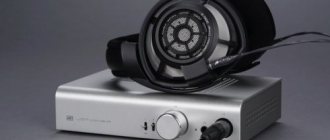Reach for the skies
Price – 343,800 rubles.
Stax SRM-T8000 Hybrid Headphone Amplifier
Price – 427,500 rubles.
To paraphrase the classic - “We say electrostatic headphones, we mean Stax. When we say Stax, we mean electrostatic headphones!” Today in our laboratory there is a top-end kit from a trendsetter in the field of home personal audio, the total cost of which is enough for a new mid-range car. Moreover, the price in this case is far from the only point that can make an impression.
The Japanese company Stax did not immediately come to a narrow specialization in headphones and amplifiers for their use. Counting its history from pre-war 1938, the company's first success came in 1954 after the release of an electrostatic high-frequency driver for acoustic systems. It was only in the early 60s that Stax began to use electrostatic technology to produce headphones - the first Stax headphones with the SR-1 index and amplifiers for their use, the SRA-4S and SRA-6S, appeared on the market. Like any Japanese company, Stax did not want to lock itself into any niche market. It did not come to the point of producing marine diesel engines and communications satellites along with audio equipment, but, remaining true to the theme of high-quality sound reproduction, Stax at different periods of its history tried to produce full-size electrostatic speakers, and tonearms for vinyl disc players, and pickup heads for them. The “digitalization” of audio did not pass the attention of the Japanese either - the company’s product range included CD players and external DACs. But in the 1990s, the decision was made to concentrate on what Stax did best - electrostatic headphones and the amplifiers to use them. And as a result, by the beginning of this century, it is quite possible to apply a quote from Mayakovsky, included in the epigraph, to the company.
Unlike diffusers of dynamic heads, for an electrostatic emitter, forces that deform the radiating surface are practically excluded, since the forces causing vibrations are applied uniformly over the entire area of the thinnest membrane, and not to the place where the diffuser is attached to the coil, which means the entire surface will move in phase and the requirements for the rigidity of the membrane not at all critical.
What is different about an electrostatic sound wave emitter? What are its advantages over the usual dynamic head and what problems does its use cause? In a conventional speaker, the cone is mechanically connected to a voice coil located in a magnetic field. Under the influence of the useful electric field created in it, the coil moves, displacing the diffuser. By oscillating, the diffuser emits sound waves into the surrounding space. In such a design, it is very important to ensure high strength of the diffuser and its minimum weight. The problem is that these are mutually exclusive requirements, so any dynamic head is essentially a compromise. The electrostatic emitter is free of such conflict. It uses a membrane whose thickness is an order of magnitude smaller than the thickness of a human hair, which means its weight can also be made as small as desired. As a result, such a membrane is practically devoid of inertia, which means it is capable of reproducing the most complex audio signals without coloration and distortion inherent in dynamic heads, and providing amazing microdynamics of the sound canvas. Such a membrane, most often made of Mylar, a thin film based on DuPont synthetic polyester fiber, is located between acoustically transparent stator grilles. A polarizing high voltage is applied to the film, which in modern Stax headphone models reaches 580 volts.
The audio signal is fed to a step-up transformer, after which it enters the stators, forming an alternating electric field between them, modulated by the useful signal. The membrane begins to vibrate, emitting sound waves. Note that in this case, unlike dynamic head diffusers, forces deforming the radiating surface are practically eliminated, since the forces causing vibrations are applied uniformly over the entire area of the membrane, and not to the place where the diffuser is attached to the coil, which means the entire surface will move in phase, and The requirements for membrane rigidity are not at all critical. Among the problems of electrostatic technology, we note the relatively high cost of producing such emitters, as well as the fact that they have to use special amplifiers containing a high-voltage power supply for polarizing the membrane, as well as a special system for controlling the stators. This is why it makes sense to consider Stax headphones only in conjunction with an amplifier. By the way, such amplifiers are produced not only by Stax - there are also offers from third-party manufacturers, for example - WES (2nd gen) Electrostatic Headphone Amplifier . Although, in any case, the range of options for audiophile experiments here is noticeably more modest compared to dynamic headphones.
So, before us is today’s top headphone model Stax SR-009, which replaced the luxurious SR-007 mk II “electrostats” on Olympus, complete with Stax’s oldest headphone amplifier with the index SRM-T8000. Both the headphones and the amplifier have significantly increased in price compared to the company’s previous top positions, but even before you start listening, after taking them out of the package, you notice what they are asking for money for. Like the Sevens, the appearance of the Stax SR-009 headphones does not at all resemble the heavy, square-plastic design of the classic Staxes. The same large round aluminum cups with stylish metal grilles that protect the delicate membranes of the electrostats from mechanical influences and the listener from high voltage. The design of the headband provides the cups with excessive freedom of positioning, which, combined with the softest leather ear pads, provides an unprecedented level of comfort during long listening sessions.
But the main differences are hidden under the hood. Firstly, the membrane, made of a new high-molecular polymer, has become even thinner and lighter - its thickness is only 2 microns. The stators of the electrostatic emitters have also undergone changes - to increase acoustic transparency, they are manufactured using proprietary MLER technology (Multi Layer Electrodes - multilayer electrodes). In addition to ensuring the unimpeded passage of sound waves, the stator design must have a resonant frequency located outside the audible range. To achieve these goals, the electrodes are made multilayer. They consist of several plates, made by photolithographic etching to achieve the required precision, which are connected at the atomic level using thermal diffusion.
The Stax SRM-T8000 amplifier is much larger than other models from the company. In width it is a quarter smaller than the standard size for a Hi-Fi component, but in depth it will give a head start to many. The heavy body is made of aluminum alloy and effectively compensates for any vibrations and resonances. The central place of the aluminum front panel plate is given to the proprietary double coaxial volume control knob, combined with a balance control. To the left of it are the power switch and two proprietary five-pin headphone jacks. Thus, two people can listen to music using the Stax SRM-T8000.
The Stax SRM-T8000 amplifier is designed to work with Pro Type headphones (a term that determines the specific polarizing voltage used). This is worth paying attention to - older Normal Type models are not compatible with this amplifier. However, such headphones have not been produced for a very long time. On the left side of the facade there are two smaller aluminum knobs - with one of them you can select the active input, and the second activates the Mute and Bypass modes, if necessary, when the volume control is excluded from the circuit. The latter feature may be useful if for some reason you need to use the source volume control.
The switching arsenal of the Stax SRM-T8000 amplifier includes one balanced input on XLR connectors, two unbalanced RCA inputs and one unbalanced output parallel to input number 1, allowing you to connect the amplifier “in gap” between the source and the pre-amplifier or integrated amplifier of a “large” system. There is also a fourth entrance, which is currently closed with a plug. We can assume that underneath there is an expansion slot into which an optional module can someday be inserted. But today we can only guess about the functionality of such a module (or modules?). Fantasy throws up the option of a DAC unit with a USB type B or SPDIF input for operating the amplifier directly with digital transports and streamers, or a phono stage module for directly connecting a vinyl record player.
The Stax SRM-T8000 amplifier is built in a fully balanced “input to output” concept and implements hybrid amplification. The input stage is implemented on a double triode 6922, and the output uses transistors in pure class A. For their effective cooling, cast finned radiators are installed in the central part of the case. To combat vibrations and external interference, special shock-absorbing and shielding casings are used for the lamps of the input stages. The amplifier's power supply uses a powerful toroidal transformer—this is the first time Stax has implemented such a solution in its amplifiers.
If you have never listened to a speaker system with electrostatic drivers, then you are in for a revelation that will certainly enhance your listening experience. You have hardly encountered such lightness, airiness and speed of presentation of musical material before. There is so much musical information that the brain sometimes cannot keep up with its flow.
A kit of such a high class places special demands on the source.
The best headphones on the planet will reveal the full potential of any source, and at the same time bring to light all its shortcomings. And sometimes this can become a problem. Chord Choral One CD player connected with Analysis Plus Silver Oval balanced cables. We started with the usual set of test tracks from the CDs of E. Grieg, “Symphonic Dances” (DG, 419 431-2), G. Verdi, “Requiem” (Philips, 442 142-2), Empire Brass Quintet and William Kuhlman, "Baroque Music for Brass and Organ" (Telarc, 80614), AC/DC "The Razors Edge", (Epic Rec., 510771 2), Blackmore's Night "Fires At Midnight" (SPV GmbH, 088-72430 CDE) , Glenn Hughes “Building the Machine” (SPV GmbH, 085-72372 CD), but it didn’t work out that way - testing such an extraordinary technique quietly turned into an inventory of the music library, which appeared in a completely new light.
If you have never listened to a speaker system with electrostatic drivers, then you are in for a revelation that will certainly enhance your listening experience. You have hardly encountered such lightness, airiness and speed of presentation of musical material before. There is so much musical information that the brain sometimes cannot keep up with its flow. Timbral neutrality is combined here with stunning transparency of the sound canvas. The entire operating frequency range is processed smoothly, without accents, which ensures neutral presentation in the best sense of the word. The set forms a large-scale stage filled with air and a mass of smallest details, creating the effect of being at a live concert. At the same time, the sound is so open that there is practically no impression of “music inside the head”, and when you stick your head into a badger hole, which is the sin of many far from the cheapest dynamic brothers. We also note the very competent scaling of the sound picture when changing the volume level. When you turn it down, the music simply becomes quieter, but the stage doesn’t shrink—a sign of top-class technology. However, this is a bright representative of this group, so there is no surprise in this.
If we compare the Stax SR-009 headphones with the younger models of the Japanese manufacturer (and by and large, the flagship can only be compared with them), then we can note that the proverb “the best is the enemy of the good” does not work here, and the question of whether perfection can be improved ceases to be rhetorical. In the new flagship, the company managed to improve the transmission of the mid- and high-frequency range, but most importantly, the Stax SR-009 headphones managed to overcome the common stereotype that “electrostats” are not very good at rock music, especially in heavy genres. True, the presentation of the Stax SR-009 still cannot boast of any special drive and “meat”, the “kick” still does not provoke the listener to stomp to the beat, and the guitar riffs in particularly dramatic places do not try to turn the soul inside out, but progress is being made in this direction definitely happened. But aggression is still not part of the Stax toolkit. However, for complex “serious” music this is hardly a disadvantage.
Another interesting feature of the Stax SR-009/SRM-T8000 system, inherent in technology of the highest level, is that in its performance well-known tracks, which you seem to know right down to the last note and the slightest aftersound, begin to play with new colors. It’s as if a talented sound engineer has remastered the soundtracks and updated your collection. This impression is so strong that it is extremely difficult to tear yourself away from listening.
Passport details:
Type – electrostatic headphones | Name - Stax SR-009 | Acoustic design - open | Frequency response, Hz – 5 – 42,000 | Electrostatic capacity, pF: 110 (including cable) | Nominal resistance, kOhm - 145 (10 kHz, including cable) | Nominal sound pressure, dB - 101 (100 V, 1 kHz) | Maximum sound pressure, dB - 118 (400 Hz) | Polarization voltage, V - 580 | Cup bodies – aluminum | Ear pads - genuine leather | Cable – Silver plated OFC copper conductors 6N (99.9999%) (6), length 2.5 meters | Weight, kg – 0.596 (with cable), 0.454 (without cable)
Type - Hybrid headphone amplifier | Name - Stax SRM-T8000 | Frequency response, Hz – 1 – 115,000 | Gain, dB - 60 (x1000) | Nonlinear distortion factor, % - 0.01 (1 kHz) | Input impedance, kOhm - 50 (RCA) / 50 x 2 (XLR) | Maximum output voltage, V - 470 (RMS) | Inputs – analog XLR, analog RCA (2) | Outputs - Analog RCA, front panel five-pin headphone jack (2) | Power consumption, W - 95 W | Additionally - slot for optional expansion modules | Dimensions, cm - 32.0 x 10.3 x 39.5 | Weight, kg - 7.3
Stax SR 009S
Reviews
— Kozlov S.
Pros: Sound, ergonomics, build quality.
Cons: Requires the use of a specific amplifier.
Comment: Considering the emergence of many headphones with a higher cost and sound quality that is not even close to comparable, the cost of the “nines” no longer raises questions. No planars even came close. As for genre, the headphones are focused more on live music. Jazz and classical are incomparable. They even cope well with classic rock, but for “bassheads” brought up on Radio Engineering and plastic boomboxes, for whom even the ATH-40x with already raised bass seems absolutely flat, they are categorically contraindicated. You shouldn't hammer nails with a microscope.
— Kolpakov Alexander
Pros: The sound is excellent, you can’t say anything, but...
Cons: Edge UNRELIABLE! I STRONGLY DO NOT ADVISE GETTING INVOLVED WITH THIS MODEL OF STAKS!!!!!!!! Don't even come near!!!!! I would have 2 of them and BOTH would have one ear covered. The first ones worked for 2 years, the second ones for a little over a year (and the second ones turned practically very little and were like new). For both, the level in one ear dropped by about 8 dB. This became immediately audible and there could be no more talk about any audiophilia. NOT REFAIRABLE!!! The service center only offered to completely replace two ear cushions with new ones. The price for repairs is 250 thousand rubles. Like this. And I definitely know another person who had exactly the same problem! This is simply a SHAME for such a “serious company” that claims to be the best! :(((((((((((((If you had the same problem, write to me at [email protected] I just wonder how many victims like me
— Lykov Stanislav
Pros: The best headphones I've ever heard, without any "buts", simply the best, and this is quite obvious.
Cons: - The price/quality ratio is terrible, but there are no competitors, so any price tag is justified... if you take into account the prices of the current tops (HD800, HE-6, LCD-3, etc.), then I would put the price on the order of 009 $3,000; — The need for a special amplifier for electrostatic headphones; — Increased requirements both for the equipment in the sound path (changing any wire will affect the sound... what are the wires, software players sound differently in these headphones), and for the recording quality itself (you will hear the slightest flaws in the recording in full volume) ; — Inadequate distribution pricing policy in Russia by STAX (in the USA 009 costs about $5,200, in Russia 240-250 thousand...).
Comment: I'm glad I bought these headphones, because... Now I just closed the issue with the headphones, I don’t hear any minuses in the sound, even moreover, the sound of 009 is better than I imagined the ideal sound in headphones... Is it worth such a significant overpayment? For me personally, the answer is unequivocal - it’s worth it... another question is that, of course, I would like STAX not to be such hucksters with godlessly inflated prices, but in the absence of competition, I can understand them... It’s difficult to write specifically about some of the sound features of these headphones, because the praises of their perfection will stupidly begin, but I’ll note something: they were compared here with LCD-2 with a non-standard cable (a cable from CablePro costing about 650 bucks), and so on old rock (Pink Floyd) and jazz with the atmosphere of a jazz club it became when compared headphones, it is clear that 009 do not convey the atmosphere of such recordings well; in 009 they sound as if musicians in tails are giving a concert at the Philharmonic, i.e. everything is incredibly clean and beautiful, but LCD-2 were closer to reality... at the same time, I liked the “fairy tales” from 009 almost more than the “truth” from LCD-2... but the fact remains that 009 sometimes “draws fairy tales” and are detached from what the performer intended when recording music, so for many this may be a minus, but for me it is not a minus, especially since without a direct comparison with the LCD-2 I would not have even noticed this.
Show all Stax SR 009S reviews
Stax SR 009S reviews Show all Stax SR 009S reviews











